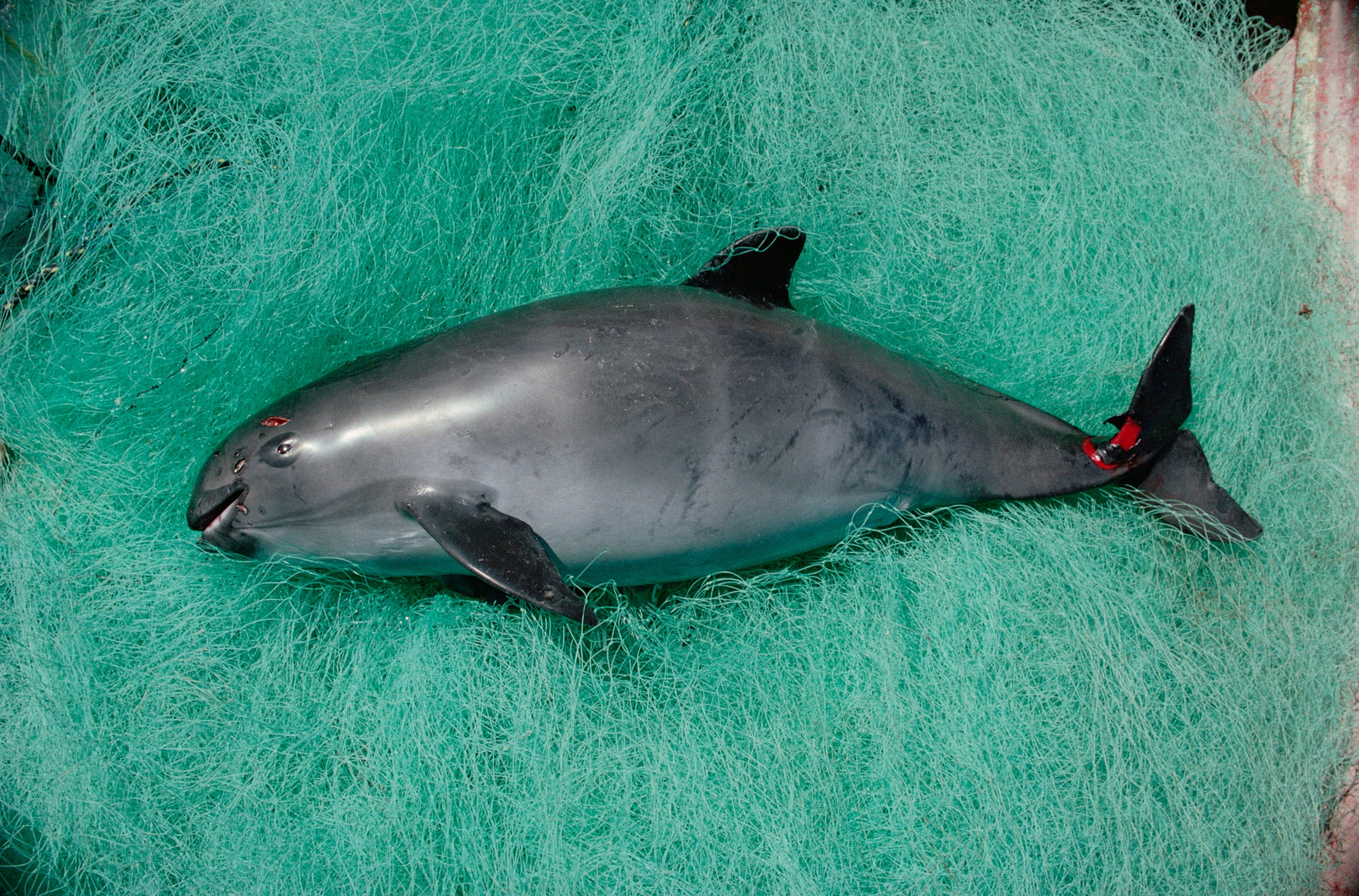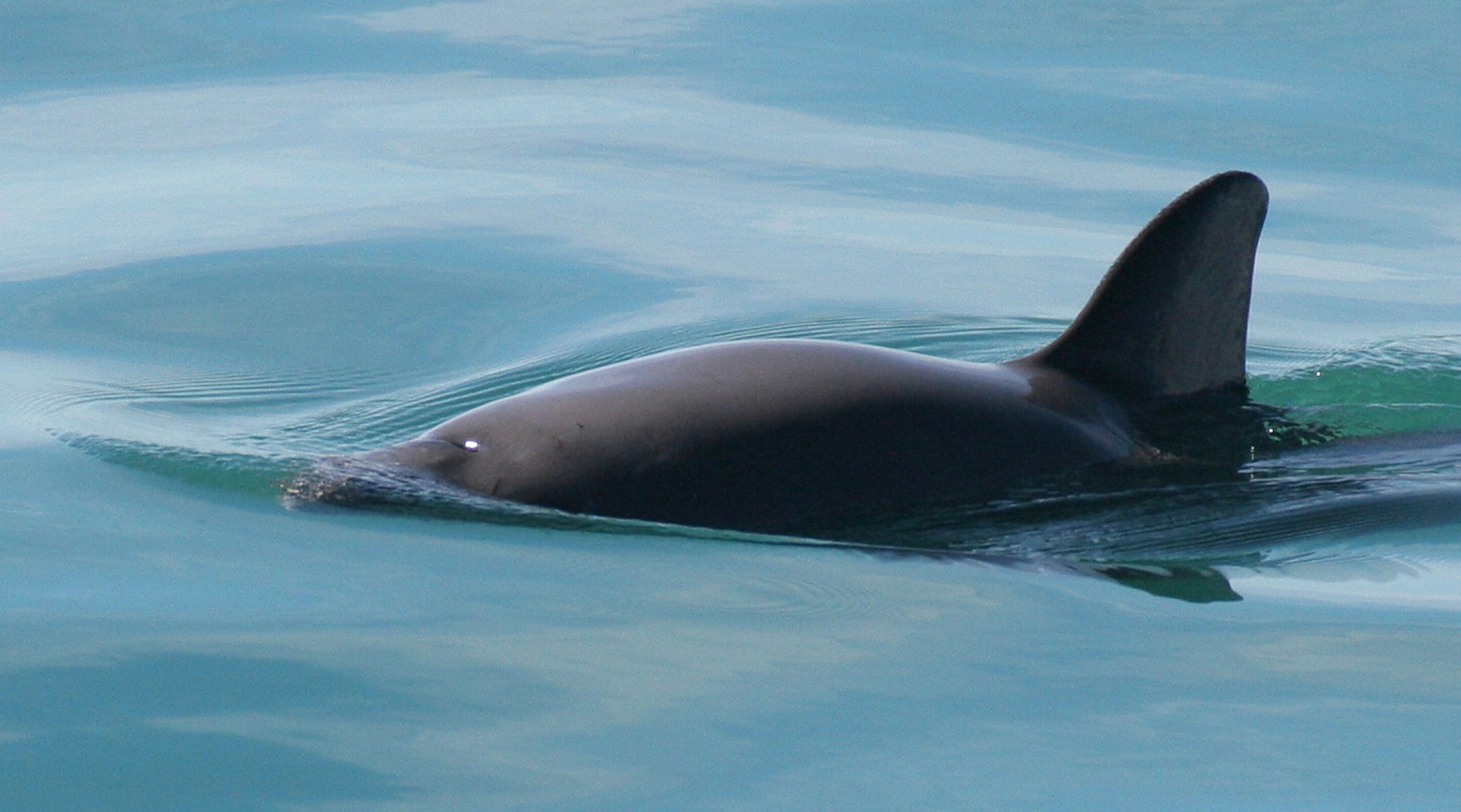
Vaquita porpoises could still recover—if illegal fishing ends now
These critically endangered marine mammals have enough genetic diversity to recover if fishers switch to sustainable gear. That's a big if.
Vaquitas are among the most endangered animals on the planet, with only 10 individuals left alive. Related to harbor porpoises, the mammals measure about five feet in length, small enough to be threatened by fishers using gillnets in the north of Mexico’s Gulf of California, the only place in the world where they occur. These finely-woven, massive nets are used to catch shrimp and fish, but too often entangle vaquitas as well.
With so few vaquitas remaining, many researchers worry that the population may not be able to recover genetically, even if gillnet fishing—which is illegal in the area where vaquitas still occur—stops. A study published May 5 in the journal Science contains some positive news, however: It suggests that the species’ genetic diversity has long been quite low, and that vaquitas may therefore be less vulnerable to inbreeding than many other species.
Using a model to explore how likely the population is to survive under different conditions, the researchers show that in scenarios where no more vaquitas die in nets, there is only a six percent chance they would go extinct. But preventing more vaquitas from dying is urgent. That part of the story is unfortunately less encouraging.

“It’s a really exciting study,” says Barbara Taylor of the U.S. National Oceanic and Atmospheric Administration, one of the authors, “because it gives scientists new tools to ask whether this species is really doomed to extinction because of genetics, or whether we should be worrying about other things.”
“All conservation is about changing human behavior,” she adds. “If that comes at an economic cost, and people can use the excuse that they’re doomed anyway, that’s bound to be a hurdle to action.”
Switching gears
Today, vaquitas only live in a very small area, about 15 miles long and 7.5 miles wide, at the far northern edge of the Gulf of California, says Taylor, who surveyed the region in 2019 and 2021. Gillnets have long been illegal there, but the bans are not enforced, she says.
“People were still setting and retrieving their gillnets, and no one made any attempt to hide it.” The only legal way to catch blue shrimp from small boats at the moment is by using small trawlers instead of gillnets, but Taylor says no such gear was observed in the northern Gulf and that all shrimp were still caught by gillnets. These shrimp are reportedly sold to industrial shrimp trawlers so they can still be exported, mostly to the United States.
An earlier effort to convince local fishermen to switch to vaquita-safe fishing gear was starting to show promise about 10 years ago, says Taylor. “That all came to a crashing halt when people started fishing for totoaba,” a rare, large fish considered endangered in Mexico that is illegal to harvest. Some people in China believe the swim bladders of this species have medicinal benefits, despite a total lack of scientific evidence. But the astronomical prices the bladders command have led to the involvement of organized crime in regional fisheries, making the use of gillnets even harder to control.

As a result, the vaquita population has now dwindled to an estimated 10 individuals, down from around 600 in 1997. To better understand the genetic diversity of the remaining vaquitas, an international team of researchers decided to sequence the entire genome of 20 animals from which body tissue samples were collected between 1985 and 2017. Like humans, vaquitas have two versions of most genes, one inherited from each of their parents. Looking at how often the two versions were identical in animals sampled in different years, the scientists could estimate how genetic diversity has changed, and how much of it remains.
The analysis suggests that vaquitas have long been rare. The study estimates that their population size had already dipped below 3,000 individuals more than 25,000 years ago. This means genetic diversity has been relatively low for a long time, says Jacqueline Robinson of the University of California in San Francisco, one of the study’s lead authors, and the data do not indicate it has dramatically decreased in the past three decades. But is that really encouraging?
Modeling extinction
That vaquita population numbers have long been low, is in fact good news, Robinson argues. Over time, many of the worst-performing variants of important genes have probably been lost whenever individuals that ended up with two copies of them died early or did not have any offspring.
“If a much larger population would have plummeted to 10 individuals over the same course of time,” she explains, “their genetic challenges would have been more severe, and their chance of going extinct much higher.”
Obviously, none of this means vaquitas are off the hook. Using the same model that allowed them to estimate past population numbers to predict what might happen in the future, the researchers estimated the chance that the species would go extinct. These numbers are just approximations, of course, says Christopher Kyriazis of the University of California, Los Angeles, who led the modeling part of the study. They reflect how often the population went extinct in the model, which was run many times over.
In scenarios where no more vaquitas die in fishing nets, the population survives 94 percent of the time, leaving a six percent chance that they would still disappear. When death from bycatch was reduced by 90 percent, extinction risk increased to 27 percent. If deaths were reduced by only 80 percent, extinction risk climbed to a staggering 62 percent.
But reducing the number of deaths from bycatch by 90 percent would mean that just one animal would die in a net roughly every 2.75 years, or every 1.5 years for an 80 percent reduction, says Kyriazis. To accomplish even that, it will be urgent to prevent gillnets from being used in the vaquitas’ habitat, which is long overdue.
A best case scenario
So how can this be done?
“Two things have to happen together,” says Taylor. “The first thing has to be: no fishing where the vaquitas are, and then, as quickly as possible, a transition to new gear. It will take governmental support to make that happen, and within Mexico, that has not been forthcoming to date.”
Banning the import of blue shrimp until illegal fisheries are rooted out might be another action. “There are some ongoing discussions with Mexico over the U.S.-Mexico-Canada trade agreement, and I think it’s really important to get honest, genuine information out there.”
Mexican government officials did not respond to several emails requesting comment from National Geographic.
Taylor stresses there is no evidence that vaquitas are recovering, and this would be a very dangerous moment to claim otherwise. But Taylor does believe the new study is good news, and the species could still be saved.
“There are other examples of wild populations that have come back from very low numbers. Northern elephant seals were down to around 30, and now they number over 300,000.” The predictions in the study for vaquitas are more humble, however, with a best case scenario of 300 individuals by 2070 if no more animals were to die as a consequence of illegal fisheries.
Providing local communities with alternatives to gillnets will be crucial, says Píndaro Díaz-Jaimes of the Universidad Nacional Autónoma de Mexico. He stresses that other measures, like ending the export of totoaba to China, will require international cooperation. In a letter to Science in August 2021, he called the then recent decision by the government to reduce efforts to control illegal fisheries ”Mexico’s final death blow to the vaquita.” Yet he does feel the new study provides some reason for hope.
“I am a bit more pessimistic,” says marine biologist Mads Peter Heide-Jørgensen of the Greenland Institute of Natural Resources, who studies whale populations in the Arctic. He cites concerns that there could be other problems for really small populations that the model may not entirely account for, such as the fact that it may become very difficult for vaquitas to find mates when there are only a few individuals left.
He agrees with the authors that the most urgent issue would be to stop the deaths from bycatch, “by the rigorous enforcement of a ban on gillnet fisheries in the primary vaquita habitat. This should have been implemented by the Mexican government long before the vaquita was driven to the edge of extinction.”
“These survivors give us a small breathing space,” says Lorenzo Rojas-Bracho, another co-author, with the United Nations Development Programme, “to shift our course to sustainable fisheries.”
It may well be the vaquitas’ last chance to catch a breath before being entangled in the nets of extinction.








